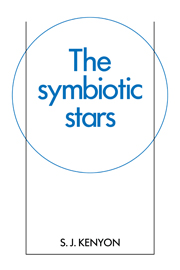Book contents
- Frontmatter
- Contents
- Preface
- 1 Introduction
- 2 The Quiescent Phase - Theory
- 3 The Quiescent Phase - Observations
- 4 The Outburst Phase - Theory
- 5 The Outburst Phase - Observations
- 6 The Formation and Evolution of Symbiotic Stars
- 7 Epilogue
- References to Chapters 1-7
- Appendix
- References to the Appendix
- Subject Index
- Individual Stars
4 - The Outburst Phase - Theory
Published online by Cambridge University Press: 26 May 2010
- Frontmatter
- Contents
- Preface
- 1 Introduction
- 2 The Quiescent Phase - Theory
- 3 The Quiescent Phase - Observations
- 4 The Outburst Phase - Theory
- 5 The Outburst Phase - Observations
- 6 The Formation and Evolution of Symbiotic Stars
- 7 Epilogue
- References to Chapters 1-7
- Appendix
- References to the Appendix
- Subject Index
- Individual Stars
Summary
Introduction
As we shall see in Chapter 5, the outbursts of symbiotic stars are very exciting events which last from a few weeks to many decades. The appearance of P Cygni-like emission line profiles in the early stages of these outbursts is naturally explained by mass ejection at a velocity of ≈100 km s−1 (e.g., Beals 1951), suggesting that some type of explosive event causes the 2–7 mag increases in brightness (cf. Figures 1.1 and 5.1–5.3). Spectroscopic observations generally show A or F-type supergiant absorption features at maximum visual light (e.g., Belyakina 1979), which diminish in intensity shortly thereafter. In this respect, symbiotics resemble classical novae, which also have A or Ftype spectra near visual maximum (Payne-Gaposchkin 1957). A few systems tend to resemble planetary nebulae at maximum, with fairly prominent Wolf-Rayet emission features pointing to rapid mass ejection via a stellar wind (Thackeray 1977).
With the development of the binary model by Berman and Hogg in the 1930's, the outburst was presumed to be associated with the hot component, although the nature of the instability was left to the imagination. Once single-star models were developed for quiescent symbiotic stars, mechanisms were proposed in which such an object could undergo multiple outbursts. Bruce (1955, 1956) likened symbiotics to tremendous thunderstorms, with outbursts resulting from electrical discharges in the extended atmosphere of an evolved red giant. Gauzit (1955), a champion of the coronal model, postulated that scaled-up versions of solar flares would explain the behavior of eruptive symbiotics, an interpretation supported by Aller and Menzel.
- Type
- Chapter
- Information
- The Symbiotic Stars , pp. 71 - 90Publisher: Cambridge University PressPrint publication year: 1986



